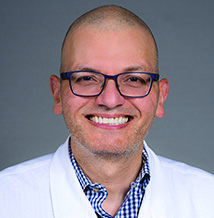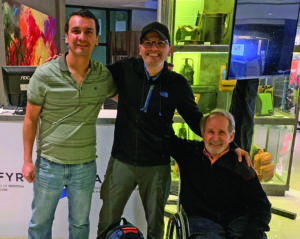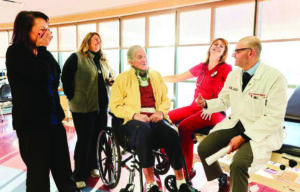
LOUISVILLE Despite spending a decade as a physical medicine and rehabilitation doctor specializing in spinal cord injury (SCI), Camilo Castillo, MD, still finds having that initial conversation around prognosis takes an emotional toll.
Castillo said, “I’ve been doing this for 10 years, and I can tell you, it doesn’t get any easier. Obviously, the conversation is really, really tough. I usually hold their hand. I give them permission to grieve. I say, ‘You need to grieve. It’s okay to cry. It’s okay to be upset.’ It’s important for them to grieve the loss of function. Why? Because after that, I want them to see their new potential.”
He adds, “My goal for them is to see what is next. To say, ‘Yes, you may not be able to walk, but you will be able to do many other things that would help you regain your independence. You can get married and have kids. You will be able to be independent again because we can give you the support you need with the resources we have, including our rehabilitation technology.’”
Growing up, Castillo witnessed this level of compassion firsthand while watching his pediatrician father interact with patients in his native Colombia. “I always admired the love that he had for his patients. I was inspired because he was such a great doctor,” Castillo says. Though his father was killed in a car accident the day before Castillo’s eighth birthday, his influence still lives on today.
Castillo received his medical degree from the Foundation Universidad Juan N. Corpas in Colombia. He then went on to complete both a residency in physical medicine & rehabilitation and a fellowship in spinal cord injury medicine at Virginia Commonwealth University School of Medicine in Richmond, Virginia.
Currently, he serves as the director of spinal cord injury programs at UofL Health – Frazier Rehab Institute in UofL Physicians – Physical Medicine and Rehabilitation (PM&R) where he does inpatient and outpatient therapy along with research.
In addition to his work with UofL, Castillo serves as a member of the American Spinal Injury Association’s (ASIA) board of directors to help bring more attention to improving SCI care for those who need it the most, especially people living in very isolated areas. He has worked with ASIA in advocacy and communication and is the “founder” of the ASIA’s Americas Committee targeting SCI education in Latin America.
Understanding Spinal Cord Injury

Of SCI, Castillo says, “This is a very challenging disease, very complex, affecting every organ in the body. And if you don’t know about it, you have us as an institution, we can help you understand it. The more understanding people have about this disease, the better for our patients.”
Spinal cord injury is a rare disorder, with only 17,800 cases occurring each year. Most patients with traumatic spinal cord injuries are between 17 and 40 years old and more often young males. Common causes are motor vehicle accidents, gunshot wounds, falls in the elderly, and sports.
Two factors affect the prognosis in spinal cord injuries: level and severity. Castillo states, “There are so many types of spinal cord injuries. You have cervical injuries, thoracic injuries, lower thoracic injuries, and each one of these levels has its unique challenges.”
The level of the injury often dictates the level of limb functionality and future difficulties. With a cervical injury affecting mainly limb function from the neck down, the likelihood of loss of control of the arms as well as legs is greater. The lower down on the spine that the injury occurs, the more limb functionality is likely.
Severity is classified using an “ASIA exam,” which scores the level of injury from A through E, with A being the most severe and E being people with more residual function, including bowel and bladder. ASIA A indicates no sensory or motor function has been preserved in the sacral segments. Castillo says, “I tell patients, ‘You want to fail this test. You want to get a D, not an A. Because a D means you still have a lot of function going on in your body. And that will give you a better functional outcome.”
Protocol and Progress
Castillo explains the protocol for SCI: “First, patients with suspected traumatic spinal cord injury should be managed in an acute trauma center, such as UofL Health – UofL Hospital, equipped with specialized services. We know that care in those types of centers has been associated with decreased length of hospitalization, cost of care, and medical complications, including pressure injury. The rehabilitation process starts soon after the patient is stabilized and able to mobilize. As soon as the patient is medically stable and able to participate for 3 hours, the patient is moved to inpatient rehabilitation.”
Castillo states, “On average, patients with cervical injuries receive inpatient care for about four weeks. We believe that the faster we get these patients mobilized, the better for them. Our bodies are not designed to be in a chair, to be in a bed. Our bodies are designed to move.”
For thoracic injuries, the stay is about two weeks, which means patients spend a much longer time rehabilitating in an outpatient setting.
It Takes a Village
Due to the complex nature of spinal cord injuries, it truly takes a network of individuals working together to enhance a patient’s chance for success.

According to Castillo, “When a patient arrives at inpatient rehab, such as Frazier Rehab, an interdisciplinary approach is essential. Members of that team should include the rehabilitation physician and nurses; physical, occupational, speech, recreational, and vocational therapists; a psychologist; and the social worker or case manager. There are also other specialized areas such as orthotics, wheelchair experts, specialized navigators and educators, and often peer mentors. Most importantly, the patient and family are members of the team.”
To assist with the all-important transition from inpatient to outpatient therapy, UofL utilizes nurse navigators to ensure patients and their families have the appropriate resources to continue their rehab process. Because of common complications, including bowel issues, urinary tract infections, skin lesions, fractures, and obesity, it is imperative that primary care physicians and nurse practitioners are educated on the importance of continued rehabilitation.
In Closing
Castillo’s main goal is increasing the level of care and accessibility for individuals with SCI. He states: “There is so much to do to enhance care access for our patients, and even more here in Kentucky, where we have a vast number of patients living in rural areas with only limited access to SCI equipment, resources, and SCI providers like me. Our department is unique with a coordinated mix between neurosurgery and PM&R. That, along with tremendous support from the university and UofL Health, has allowed me to build an SCI program that fits the population we serve.”


